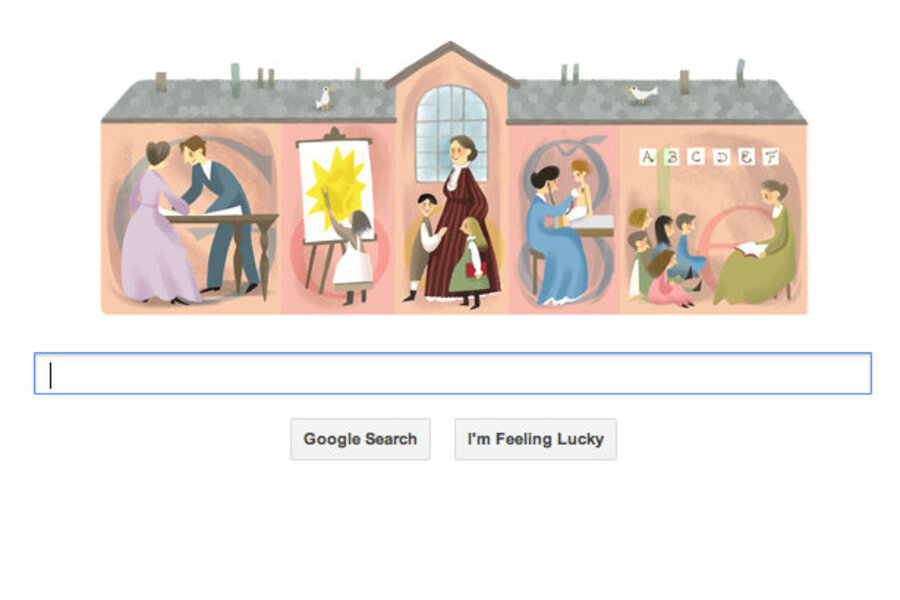Jane Addams, world's 'best-loved woman,' honored with Google doodle
In September of 1889, Jane Addams, just 29 years old, opened a red house at 800 South Halsted Street in Chicago as a place of refuge for the new immigrants to the blighted neighborhood. That home, pictured today in a Google doodle that celebrates Ms. Addams, would become the tangible epicenter of Addams’s work and her vision for a fairer, more peaceful world.
Addams, who is credited in the New York Times 1935 obituary for her work in developing “a scientific approach to the relief of poverty and suffering,” is difficult to categorize. That’s perhaps due to the sheer number of titles that have been given to her – feminist; social activist; internationalist; philosopher; author; and sociologist.
Addams was born to Quaker parents in Cedarville, Illinois on Sept. 6, 1860. Her father, a miller, was a former congressman and friend to Abraham Lincoln, and Addams would later credit the belief both men had in the equality of man as underpinning her own hope for the equality of all people, women included.
Addams, an 1881 graduate of Rockford College for Women, moved with Ellen Gates Starr (the two were a couple) to Chicago in 1889. There, she founded Hull House and began receiving Chicago’s new immigrants from all around the world into the home.
At Addams’s leased mansion, where numbers burgeoned to around 2,000 each week after just a year of operations, immigrants paid rent to receive lessons in the English language and American government, as well as practical skills like cooking and sewing. Addams’s goal was assimilation – an iconoclastic goal at a time at which immigrants were often ghettoized and de facto barred from middle class life.
That home soon became the locus of Addams’ broader social activism. No topic, so long as it gestured toward broader fairness for all people, was outside the bounds of Addams’ advocacy: Her work included pushing for more opportunities for women, for the poor, and for immigrants; She was a pacifist and fought against war with Germany and, later, for generous peace terms; She pressed for better sanitary conditions in Chicago, taking up the official post of garbage inspector of the Nineteenth Ward, and for more sensitive care for the mentally ill, disabled, and sick. She wanted better milk, better midwife training, and better childcare.
Some of those beliefs made fast enemies for Addams. In particular, her progressive support for and representation of women’s equal rights made her unpopular with leading male figures: In 1912, Charles Elliot, the president of Harvard at the time, criticized what he called Addams’s politics after she seconded Franklin D. Roosevelt’s nomination for president. “Women,” he wrote in an interview published in the New York Times, “have no proper share in political convention.” Addams’ participation was “in very bad taste," he said.
And her disdain for war was equally ill-received in certain camps. In letters published in the press as the US lunged into world war, the parents of World War I soldiers lampooned her pacifism. Addams, wrote one of them, “evidently knows nothing of the joys of combat.” Around that time, as Addams began taking up positions in anti-war groups, the Daughters of the American Revolution also booted her out.
Even now, Addams is a controversial figure. Recent biographies that plumb her early life and work have noted that Hull House was a patriarchal, evangelist place, where immigrants were objects of sympathy that required rescuing from their old ways of life.
But, for all the criticism, Addams was and is regarded as an extraordinary figure, even by most of her critics. In 1931, Addams, already the first woman to have received an honorary degree from Yale University, was awarded the Noble Peace Prize, making her the first American woman to win that award.
A few weeks before her death, Addams was the guest of honor at a dinner in Washington, where Eleanor Roosevelt called her “the greatest living woman.” That, the New York Times obituary said, was just one of the titles – as numerous as the causes for which Addams fought – that had been given to her. “Miss Addams,” the Times wrote, “has been called ‘the greatest woman in the world,’ the ‘mother of social service,’ ‘the greatest woman internationalist’ and the ‘first citizen of Chicago.’ And the Times added its own to the list: “She was, perhaps, the world's best-known and best-loved woman.”






